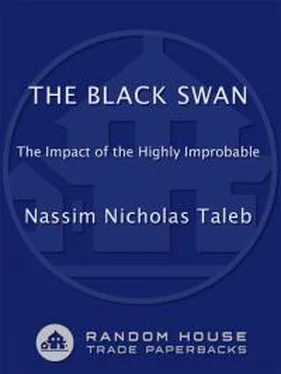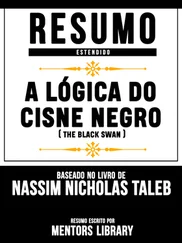So let me describe Mandelbrotian geometry.
The Geometry of Nature
Triangles, squares, circles, and the other geometric concepts that made many of us yawn in the classroom may be beautiful and pure notions, but they seem more present in the minds of architects, design artists, modern art buildings, and schoolteachers than in nature itself. That’s fine, except that most of us aren’t aware of this. Mountains are not triangles or pyramids; trees are not circles; straight lines are almost never seen anywhere. Mother Nature did not attend high school geometry courses or read the books of Euclid of Alexandria. Her geometry is jagged, but with a logic of its own and one that is easy to understand.
I have said that we seem naturally inclined to Platonify, and to think exclusively in terms of studied material: nobody, whether a bricklayer or a natural philosopher, can easily escape the enslavement of such conditioning. Consider that the great Galileo, otherwise a debunker of falsehoods, wrote the following:
The great book of Nature lies ever open before our eyes and the true philosophy is written in it. … But we cannot read it unless we have first learned the language and the characters in which it is written. … It is written in mathematical language and the characters are triangles, circles and other geometric figures.
Was Galileo legally blind? Even the great Galileo, with all his alleged independence of mind, was not capable of taking a clean look at Mother Nature. I am confident that he had windows in his house and that he ventured outside from time to time: he should have known that triangles are not easily found in nature. We are so easily brainwashed.
We are either blind, or illiterate, or both. That nature’s geometry is not Euclid’s was so obvious, and nobody, almost nobody, saw it.
This (physical) blindness is identical to the ludic fallacy that makes us think casinos represent randomness.
Fractality
But first, a description of fractals. Then we will show how they link to what we call power laws, or scalable laws.
Fractal is a word Mandelbrot coined to describe the geometry of the rough and broken —from the Latin fractus , the origin of fractured. Fractality is the repetition of geometric patterns at different scales, revealing smaller and smaller versions of themselves. Small parts resemble, to some degree, the whole. I will try to show in this chapter how the fractal applies to the brand of uncertainty that should bear Mandelbrot’s name: Mandelbrotian randomness.
The veins in leaves look like branches; branches look like trees; rocks look like small mountains. There is no qualitative change when an object changes size. If you look at the coast of Britain from an airplane, it resembles what you see when you look at it with a magnifying glass. This character of self-affinity implies that one deceptively short and simple rule of iteration can be used, either by a computer or, more randomly, by Mother Nature, to build shapes of seemingly great complexity. This can come in handy for computer graphics, but, more important, it is how nature works. Mandelbrot designed the mathematical object now known as the Mandelbrot set, the most famous object in the history of mathematics. It became popular with followers of chaos theory because it generates pictures of ever increasing complexity by using a deceptively minuscule recursive rule; recursive means that something can be reapplied to itself infinitely. You can look at the set at smaller and smaller resolutions without ever reaching the limit; you will continue to see recognizable shapes. The shapes are never the same, yet they bear an affinity to one another, a strong family resemblance.
These objects play a role in aesthetics. Consider the following applications:
Visual arts: Most computer-generated objects are now based on some version of the Mandelbrotian fractal. We can also see fractals in architecture, paintings, and many works of visual art—of course, not consciously incorporated by the work’s creator.
Music: Slowly hum the four-note opening of Beethoven’s Fifth Symphony: ta-ta-ta-ta . Then replace each individual note with the same four-note opening, so that you end up with a measure of sixteen notes. You will see (or, rather, hear) that each smaller wave resembles the original larger one. Bach and Mahler, for instance, wrote submovements that resemble the larger movements of which they are a part.
Poetry: Emily Dickinson’s poetry, for instance, is fractal: the large resembles the small. It has, according to a commentator, “a consciously made assemblage of dictions, metres, rhetorics, gestures, and tones.”
Fractals initially made Benoît M. a pariah in the mathematical establishment. French mathematicians were horrified. What? Images? Mon dieu! It was like showing a porno movie to an assembly of devout Eastern Orthodox grandmothers in my ancestral village of Amioun. So Mandelbrot spent time as an intellectual refugee at an IBM research center in upstate New York. It was a f*** you money situation, as IBM let him do whatever he felt like doing.
But the general public (mostly computer geeks) got the point. Mandelbrot’s book The Fractal Geometry of Nature made a splash when it came out a quarter century ago. It spread through artistic circles and led to studies in aesthetics, architectural design, even large industrial applications. Benoît M. was even offered a position as a professor of medicine! Supposedly the lungs are self-similar. His talks were invaded by all sorts of artists, earning him the nickname the Rock Star of Mathematics. The computer age helped him become one of the most influential mathematicians in history, in terms of the applications of his work, way before his acceptance by the ivory tower. We will see that, in addition to its universality, his work offers an unusual attribute: it is remarkably easy to understand.
A few words on his biography. Mandelbrot came to France from Warsaw in 1936, at the age of twelve. Owing to the vicissitudes of a clandestine life during Nazi-occupied France, he was spared some of the conventional Gallic education with its uninspiring algebraic drills, becoming largely self-taught. He was later deeply influenced by his uncle Szolem, a prominent member of the French mathematical establishment and holder of a chair at the Collège de France. Benoît M. later settled in the United States, working most of his life as an industrial scientist, with a few transitory and varied academic appointments.
The computer played two roles in the new science Mandelbrot helped conceive. First, fractal objects, as we have seen, can be generated with a simple rule applied to itself, which makes them ideal for the automatic activity of a computer (or Mother Nature). Second, in the generation of visual intuitions lies a dialectic between the mathematician and the objects generated.
Now let us see how this takes us to randomness. In fact, it is with probability that Mandelbrot started his career.
A Visual Approach to Extremistan/Mediocristan
I am looking at the rug in my study. If I examine it with a microscope, I will see a very rugged terrain. If I look at it with a magnifying glass, the terrain will be smoother but still highly uneven. But when I look at it from a standing position, it appears uniform—it is almost as smooth as a sheet of paper. The rug at eye level corresponds to Mediocristan and the law of large numbers: I am seeing the sum of undulations, and these iron out . This is like Gaussian randomness: the reason my cup of coffee does not jump is that the sum of all of its moving particles becomes smooth. Likewise, you reach certainties by adding up small Gaussian uncertainties: this is the law of large numbers.
Читать дальше












